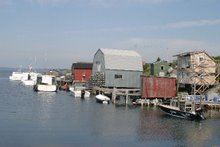Whales and Dolphins
Largest Whale: Blue Whale, Balaenoptera musculusfemale: 33.27 meters (109 feet 3.5 inches) 190 tons estimated weightmale: 32.64 meters (107 feet 1 inch)Both captured near the South Shetland Islands in 1926
Largest Fin Whale, Balaenoptera physalus 90 feet, 97 tons estimated weight
Largest Sei Whale, Balaeonoptera borealis 72 feet, 45 tons estimated weight
Largest Sperm Whale, Physeter catodon 67 feet 10 inches, 72 tons estimated weight
Largest Humpback Whale, Megaptera novaeangliae 65 feet, 64 tons estimated weight
Largest Gray Whale, Eschrichtius robustus 51 feet, 39 tons
Fastest Swimming Baleen Whale (short distance)Sei Whale, Balaenoptera borealis: 35 miles per hour in short bursts
Fastest Swimming Dolphin:
Dall's porpoise, Phocoenoides dalli, recorded at 56 km/hr
Killer Whale, Orcinus orca , recorded at 56 km/hr
Common Dolphin, Delphinus delphis - 37 km/hr
Seals and Sea Lions
Largest Northern Elephant Seal, Mirounga angustirostris: 18 feet, taken in 1852 off Santa Barbara Island, 15 feet 7 inches taken in 1929 off San Diego
Largest Southern Elephant Seal, Mirounga leonina: 21 feet, 4 inches, taken near South Georgia Island in 1913
Smallest Pinniped: Baikal Seal, Pusa sibiricaAdults are 4 feet 6 inches and 140 pounds
Fastest Swimming Pinniped: California Sea Lion, Zalophus californianus 25 miles per hour
Greatest Age for a Pinniped:Ringed Seal, Phoca hispida: 43 years, collected on Baffin Island and based on growth layers in the teethGrey Seal, Halichoerus grypus, 41-42 years, kept in captivity in Sweden from 1901-1942
Fish
Largest Fish Whale Shark, Rhinodon typus 59 feet, for a specimen captured in Thailand in 1919
Largest Basking Shark, Cetorhinus maximus 45 feet. Weight estimated at 32,000 pounds
Largest Tiger Shark, Galeocerdo cuvieri 20 feet, 10 inches, 2070 pounds
Largest Hammerhead Shark, Sphyrna mokarran 18 feet, 4 inches, 1,860 pounds
Largest Thresher Shark, Alopias vulpinus 18 feet, 1,100 pounds
Largest Six-gill Shark, Hexanchus griseus 15 feet, 1,300 pounds
Heaviest Fish in the Class Ostyichtheys (bony fish)Ocean Sunfish, Mola mola: 10 feet in length, 14 feet between dorsal and anal fins, 4,928 pounds, struck and killed by a ship off Australia in 1908
Longest Fish in the Class Ostyichtheys (bony fish)Russian Sturgeon, Acipenser huso: 24 feet in length, weight 1,470 kg (3,250 pounds) caught in the Volga river in 1827
Shortest Marine FishSchindleria praematurus, found in Samoa in the South Pacific: 12-19 mm in length, weight 2 mg.
Fastest Fish:
Sailfish, Istiophorus platypterus: 68.18 mph
Mako Shark, Isurus oxyrinchus: 60 mph
Marlin, Tetrapturus sp. 50 mph
Wahoo, Acanthocybium solandri 48.5 mph
Bluefin Tuna, Thunnus thynnus 43.4 mph
Blue Shark, Prionace glauca 43 mph
Bonefish, Albula vulpes 40 mph
Swordfish, Xiphius gladius 40 mph
Slowest Fish:Sea Horse 0.01 mph
Echinoderms
Largest Sea Star: Evasterias echinosomo 96 cm (37.79 inches) in diameter, weight 5 kg (11 pounds), collected in the North Pacific
Smallest Sea Star: Leptychaster propinquus 1.83 cm (0.72 inches) total diameter
Deepest Sea Star: Eremicaster tenebrariusCollected in 7,630 meters (25,032 feet)
Fastest Sea Star: Sun Star, Pycnopodia helianthoides 75 cm per minute (0.027 miles per hour)
Largest Sea Urchin: Sperosoma giganteumTest diameter of 38 cm (13 inches)
Smallest Sea Urchin: Echinocyamus scaberTest diameter of 5.5 mm (0.21 inches)
Deepest Sea Urchin: Unidentified specimentaken from 7,250 meters (23,786 feet) near Indonesia in 1951
Largest Sea Cucumber: Members of the genus Stichopus have been measured up to 1.3 meters (40 inches) in length and 20 cm (8 inches) in diameter
Smallest Sea Cucumber: Rhabdomolgus ruber, found in the North Sea10 mm (0.39 inches) in length
Deepest Sea Cucumber: Unidentified specimen taken from the Philippine trench in 1951 in 10,190 meters (33,431 feet)
Largest Crinoid: Helimoetra glacialis, found in the Northeast Pacific90 cm (36 inches) in diameter
Smallest Crinoid: Unidentified species with a diameter of 3 cm (1.18 inches)
Deepest Crinoid: Unidentified specimen taken from the Kermadec Trench in 1951 in 8,210 meters (26,935 feet)
Crustaceans
Largest Crustacean: Giant spider crab Macrocheira kaempferiIndividuals can measure 12-14 inches across the body, with a claw span of 8-9 feet. There is a report of a crab weighing 14 pounds with a claw span of 12 feet.
Smallest Crab: Pea crabs in the family Pinnotheridae are about .25 inches across the shell
Heaviest Crustacean: Atlantic Lobster The record, however goes to a lobster weighing 44 pounds, 4 ounces, which was caught in Nova Scotia waters.
Molluscs
Heaviest Mollusc (and heaviest invertebrate): The giant squid (Architeuthis sp.)The largest giant squid ever recorded (Architeuthis princeps) was captured in 1878. One of the "arms" (probably a tentacle) measured 35 feet long. It is estimated that the animal weighed in the neighbourhood of 4000 pounds.
Largest Clams: Tridacna gigas, with a length of 137cm, as reported by Rosewater, J. 1965. The family Tridacnidae in the Indo-Pacific. Indo-Pacific Mollusca 1: 347-396. Tridacna derasa, found on coral reefs in the South Pacific. One was collected on the Great Barrier Reef in 1917 that measured 49 inches by 29 inches, and weighed 579.5 pounds.
Largest Gastropod: Syrinx aruanus, the trumpet or baler conch found off the coast of Australia. In 1979, a 40 pound animal was found with a shell that measured 30.4 inches in length and 39.75 inches in girth.
Cnidarians
Largest Jellyfish: Cyanea arctica, found in the North AtlanticSpecimens have been measured up to 7 feet 6 inches across the bell with a tentacle of 120 feet.
Porifera
Largest Sponge: Xestospongia muta, the barrel sponge, found in tropical coastal waters. Some individuals in the Caribbean measure 6-8 feet tall, and 6-8 feet across. It should be noted, however, that some species of encrusting sponge can cover a very large area.
Seaweed
Largest Seaweed: Macrocystis pyrifera, a brown algae called the giant kelp. The longest recorded length is 54 metres long! M. pyrifera is the type of kelp that makes up the majority of the giant kelp forests off the California coast.
Thursday, March 29, 2007
Subscribe to:
Post Comments (Atom)

1 comment:
When I came across this information, I thought it would be fun to post and see if anyone could find anything different.
Post a Comment